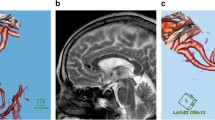Abstract
Background
Pericallosal artery aneurysms differ from other cerebral aneurysms for the difficulty in establishing proximal vascular control during surgical clipping. A frontomedial craniotomy with combined pterional and interhemispheric approach allows obtaining a better proximal control.
Materials and methods
We present our surgical technique to achieve a proximal vessel control in pericallosal artery aneurysm clipping using a combined pterional and interhemispheric approach through frontomedial craniotomy. This surgical technique is illustrated by an intraoperative video.
Conclusion
Proximal control for pericallosal artery aneurysm clipping can be challenging. In selected cases, a single craniotomy allows performing two approaches and obtaining a safer proximal control for surgical clipping.




Similar content being viewed by others
Abbreviations
- ACA:
-
Anterior cerebral artery
- AComA:
-
Anterior communicating artery
- DSA:
-
Digital subtraction angiography
- EEG:
-
Electroencephalogram
- ICA:
-
Internal carotid artery
- MEPs:
-
Motor evoked potentials
- MCA:
-
Middle cerebral artery
- PeA:
-
Pericallosal artery
- CMA:
-
Callosomarginal artery
- PCA:
-
Posterior cerebral artery
- SSEPs:
-
Somato-sensory evoked potentials
- SSS:
-
Superior sagittal sinus
References
Inoue K, Seker A, Osawa S, Alencastro LF, Matsushima T, Rhoton AL Jr (2009) Microsurgical and endoscopic anatomy of the supratentorial arachnoidal membranes and cisterns. Neurosurgery 65:644–664; discussion 665. https://doi.org/10.1227/01.NEU.0000351774.81674.32
Kiyofuji S, Inoue T, Tamura A, Saito I (2015) Combined interhemispheric and pterional approach for ACOM and left MCA aneurysms. Neurosurg Focus 38:Video 15. https://doi.org/10.3171/2015.V1.FOCUS14559
Lee JW, Lee KC, Kim YB, Huh SK (2008) Surgery for distal anterior cerebral artery aneurysms. Surg Neurol 70:153–159; discussion 159. https://doi.org/10.1016/j.surneu.2008.03.012
Park J (2017) Pterional or subfrontal access for proximal vascular control in anterior interhemispheric approach for ruptured pericallosal artery aneurysms at risk of premature rupture. J Korean Neurosurg Soc 60:250–256. https://doi.org/10.3340/jkns.2016.0910.009
Park J, Hamm IS (2004) Anterior interhemispheric approach for distal anterior cerebral artery aneurysm surgery: preoperative analysis of the venous anatomy can help to avoid venous infarction. Acta Neurochir 146:973–977; discussion 977. https://doi.org/10.1007/s00701-004-0304-6
Perlmutter D, Rhoton AL Jr (1978) Microsurgical anatomy of the distal anterior cerebral artery. J Neurosurg 49:204–228. https://doi.org/10.3171/jns.1978.49.2.0204
Rhoton AL Jr (2002) The cerebral veins. Neurosurgery 51:S159–S205
Rhoton AL Jr (2002) The supratentorial arteries. Neurosurgery 51:S53–S120
Rhoton AL Jr (2007) The cerebrum. Anatomy Neurosurg 61:37–118; discussion 118-119. https://doi.org/10.1227/01.NEU.0000255490.88321.CE
Author information
Authors and Affiliations
Corresponding author
Ethics declarations
The patient gave his informed consent for the redaction and publication of the paper and the intraoperative video.
Additional information
Publisher’s note
Springer Nature remains neutral with regard to jurisdictional claims in published maps and institutional affiliations.
This article is part of the Topical Collection on Vascular Neurosurgery – Aneurysm
Electronic Supplementary Material
Intraoperative video of pterional-paramedian craniotomy to perform combined trans-Sylvian interhemispheric approach to clip middle cerebral artery and pericallosal artery aneurysms. This is the case of a 59-year-old patient, under antiplatelet treatment for ischemic cardiopaty and known for high blood pressure, hypercholesterolemy, obesity, and familiar history of aneurysmal subarachnoidal haemorrhage (father at the age of 40 years old). The patient underwent CT scan after seizure for severe hyponatremia. The CT scan showed incidentally a 5 mm aneurysm of the right anterior pericallosal artery, located at the bifurcation between the pericallosal and callosomarginal arteries, and a 4 mm aneurysm at the right middle cerebral artery bifurcation oriented superiorly. Considering the age of the patients and the vascular risk factors and the familiar hystory, we decided to treat both the aneurysms via a combined pterional-interhemispheric approach. The pre and post operative DSA images and each phase of surgery are presented and described in the video by the author (MP4 32940 kb)
Rights and permissions
About this article
Cite this article
Bonasia, S., Robert, T. Retractorless combined pterional and interhemispheric approach to achieve proximal control in pericallosal artery aneurysm: how I do it. Acta Neurochir 163, 2733–2738 (2021). https://doi.org/10.1007/s00701-021-04782-7
Received:
Accepted:
Published:
Issue Date:
DOI: https://doi.org/10.1007/s00701-021-04782-7




